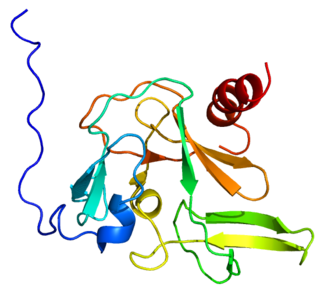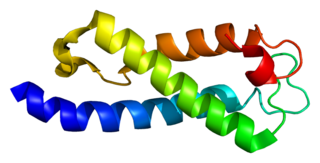
Lysine-specific histone demethylase 1A (LSD1) also known as lysine (K)-specific demethylase 1A (KDM1A) is a protein that in humans is encoded by the KDM1A gene. LSD1 is a flavin-dependent monoamine oxidase, which can demethylate mono- and di-methylated lysines, specifically histone 3, lysine 4 (H3K4). Other reported methylated lysine substrates such as histone H3K9 and TP53 have not been biochemically validated. This enzyme plays a critical role in oocyte growth, embryogenesis, hematopoiesis and tissue-specific differentiation. LSD1 was the first histone demethylase to be discovered though more than 30 have since been described.

5′-3′ exoribonuclease 1 (Xrn1) is a protein that in humans is encoded by the XRN1 gene. Xrn1 hydrolyses RNA in the 5′ to 3′ direction.

Histone-lysine N-methyltransferase 2A, also known as acute lymphoblastic leukemia 1 (ALL-1), myeloid/lymphoid or mixed-lineage leukemia1 (MLL1), or zinc finger protein HRX (HRX), is an enzyme that in humans is encoded by the KMT2A gene.

PR domain zinc finger protein 2 is a protein that in humans is encoded by the PRDM2 gene.

Lysine N-methyltransferase 2C (KMT2C) also known as myeloid/lymphoid or mixed-lineage leukemia protein 3 (MLL3) is an enzyme that in humans is encoded by the KMT2C gene.

Lysine-specific demethylase 5C is an enzyme that in humans is encoded by the KDM5C gene. KDM5C belongs to the alpha-ketoglutarate-dependent hydroxylase superfamily.

Histone-lysine N-methyltransferase SETD7 is an enzyme that in humans is encoded by the SETD7 gene.

SET domain containing 2 is an enzyme that in humans is encoded by the SETD2 gene.

SET and MYND (myeloid-Nervy-DEAF-1) domain-containing protein 3 is a protein that in humans is encoded by the SMYD3 gene.

Histone-lysine N-methyltransferase 2D (KMT2D), also known as MLL4 and sometimes MLL2 in humans and Mll4 in mice, is a major mammalian histone H3 lysine 4 (H3K4) mono-methyltransferase. It is part of a family of six Set1-like H3K4 methyltransferases that also contains KMT2A, KMT2B, KMT2C, KMT2F, and KMT2G.

Lysine-specific demethylase 5B also known as histone demethylase JARID1B is a demethylase enzyme that in humans is encoded by the KDM5B gene. JARID1B belongs to the alpha-ketoglutarate-dependent hydroxylase superfamily.

N-lysine methyltransferase KMT5A is an enzyme that in humans is encoded by the KMT5A gene. The enzyme is a histone methyltransferase, SET domain-containing and lysine-specific. The enzyme transfers one methyl group to histone H4 lysine residue at position 20. S-Adenosyl methionine (SAM) is both the cofactor and the methyl group donor. The lysine residue is converted to N6-methyllysine residue.

PHD finger protein 8 is a protein that in humans is encoded by the PHF8 gene.

Histone-lysine N-methyltransferase KMT5B is an enzyme that in humans is encoded by the KMT5B gene. The enzyme along with WHSC1 is responsible for dimethylation of lysine 20 on histone H4 in mouse and humans.

SET domain containing 6 is a protein in humans that is encoded by the SETD6 gene.

Lysine demethylase 6B is a protein that in humans is encoded by the KDM6B gene.

Lysine methyltransferase 2E is a protein that in humans is encoded by the KMT2E gene.

SET domain containing 1B is a protein that in humans is encoded by the SETD1B gene.

SET domain containing 3 (SETD3) is a protein that in humans is encoded by the SETD3 gene. It is a methyl transferase implicated in the replication of all enteroviruses. A mouse line deficient in SETD3 expression was shown to be immune to enterovirus infection. This could pave the way for the prevention of diseases like the common cold, myocarditis, aseptic meningitis and polio. SETD3 is capable of methylating the cytoskeletal protein actin on histidine residues.

Ankyrin repeat domain 11 is a protein that in humans is encoded by the ANKRD11 gene.



















